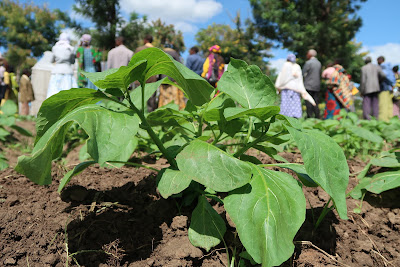Swiss chard is a green leafy vegetable that makes a good alternative to spinach.
Growing Chard can be easier than growing spinach as it is better able to
withstand higher temperatures and water shortages as compared to spinach.
Despite
its value as a food crop Swiss chard also has a very striking value as an
ornamental plant and so often appears in a gardens ornamental borders or
ornamental pots. Chard is an excellent source of vitamins and minerals. It's
stalks can be of various colors. Chard is known by a number of different names
in including Swiss chard, Spinach Beet, and Leaf beet.
Land Preparation
Dig over the soil and mix the soil with some organic matter a number of weeks before sowing. This will help soil moisture retention and soil aeration. Make sure to break up any large clods of soil with your fork and rake the soil to obtain a fine soil structure in which to plant your Chard seeds.
Sowing
Sow
Chard in early spring to avoid the final hard frosts. Chard is normally sown
directly into the soil, not in seed trays for later transplanting. Sow the
Chard seed in rows around 45 cm apart and about 5 cm apart. The seeds should be
sown at around 1 - 1.5 cm depth. Germination can take anywhere around 1-2
weeks.
The
plants will need thinning to about 15-25 cm between plants. If left until
around 15 cm in height before thinning then the thinned plants can be treated
like an early harvest and the young leaves will be extremely tender and tasty.
Position
When
growing Chard you should position the plants in a spot that receives a good
amount of sunlight. Chard will tolerate partial shade but will give a better
yield when in a sunny spot. Chard is a cool weather vegetable and may withstand
a very mild frost.
Soil
type
Chard
doesn't like a soil that is too acidic, an acidic soil will stunt growth. Chard
grows well in a soil of around 6.5 - 6.8. The soil should be able well drained
but be able to hold moisture well so a soil with a good amount of organic
matter is ideal.
Tending
To
extend harvesting past the first hard frost you can put the plants under a
cloche or poly-tunnel to extend the growing season. Chard is sturdier than
spinach and can cope better with water shortages, however you should still
water regularly to ensure optimum growth and prevent bolting. Bolting leads to
premature flower and seed production and will divert the plants energies away
from leaf growth.
Harvesting
Chard
is a pick and come again crop. For multiple harvests from the same plant simply
pick the outer leaves and leave the inner younger leaves. You can pick leaves
after they have reached around 15 cm in length. Chard can be harvested until
the first hard frost this way.
Chard
does not store well so should either be eaten within a few hours of picking or
stored in the salad box of the fridge for a maximum of 3 days. Be sure not to
damage the central terminal bud at the centre of the young growth
You
can also if you wish harvest the whole plant. After picking the leaves simply
wash and add to salads or wash and then quickly heat in a pan using only the
water that clings to the leaves after washing. This will avoid overcooked soggy
chard leaves.
Varieties
Chard
varieties are available with a variety of stalk colors - red, yellow and white.




